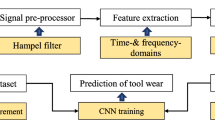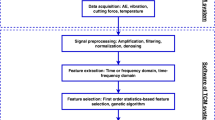Abstract
Surface roughness is one of the most critical attributes of machined components, especially those used in high-performance systems. Online surface roughness monitoring offers advancements comparable to post-process inspection methods, reducing inspection time and costs and concurrently reducing the likelihood of defects. Currently, online monitoring approaches for surface roughness are constrained by several limitations, including the reliance on handcrafted feature extraction, which necessitates the involvement of human experts and entails time-consuming processes. Moreover, the prediction models trained under one set of cutting conditions exhibit poor performance when applied to different experimental settings. To address these challenges, this work presents a novel deep-learning-assisted online surface roughness monitoring method for ultraprecision fly cutting of copper workpieces under different cutting conditions. Tooltip acceleration signals were acquired during each cutting experiment to develop two datasets, and no handcrafted features were extracted. Five deep learning models were developed and evaluated using standard performance metrics. A convolutional neural network stacked on a long short-term memory network outperformed all other network models, yielding exceptional results, including a mean absolute percentage error as low as 1.51% and anR2 value of 96.6%. Furthermore, the robustness of the proposed model was assessed via a validation cohort analysis using experimental data obtained using cutting parameters different from those previously employed. The performance of the model remained consistent and commendable under varied conditions, asserting its applicability in real-world scenarios.
Similar content being viewed by others
References
Zhang S J, To S, Zhu Z W, et al. A review of fly cutting applied to surface generation in ultra-precision machining. Int J Machine Tools Manufacture, 2016, 103: 13–27
G. G, Malayath G, Mote R G. A review of cutting tools for ultra-precision machining. Machining Sci Tech, 2022, 26: 923–976
Manjunath K, Tewary S, Khatri N, et al. In-process monitoring of the ultraprecision machining process with convolution neural networks. Int J Comput Integrated Manuf, 2024, 37: 37–54
Zhang Z, Yan J, Kuriyagawa T. Manufacturing technologies toward extreme precision. Int J Extrem Manuf, 2019, 1: 022001
Wang W, Xie Z W. Fabrication of a biomimetic controllable adhesive surface by ultraprecision multistep and layered scribing and casting molding. Sci China Tech Sci, 2021, 64: 1814–1826
Huang P T B, Zhang H J, Lin Y C. Development of a Grey online modeling surface roughness monitoring system in end milling operations. J Intell Manuf, 2019, 30: 1923–1936
Rao K V, Kumar Y P, Singh V K, et al. Vibration-based tool condition monitoring in milling of Ti-6Al-4V using an optimization model of GM(1,N) and SVM. Int J Adv Manuf Technol, 2021, 115: 1931–1941
Yamato S, Nakanishi K, Suzuki N, et al. Development of automatic chatter suppression system in parallel milling by real-time spindle speed control with observer-based chatter monitoring. Int J Precis Eng Manuf, 2021, 22: 227–240
Manjunath K, Tewary S, Khatri N, et al. Monitoring of machining process anomalies in diamond turning of Ti6Al4V alloy using transfer learning-based algorithms. Comput Industrial Eng, 2023, 182: 109359
Korkmaz M E, Gupta M K, Li Z, et al. Indirect monitoring of machining characteristics via advanced sensor systems: A critical review. Int J Adv Manuf Technol, 2022, 120: 7043–7078
Lauro C H, Brandão L C, Baldo D, et al. Monitoring and processing signal applied in machining processes—A review. Measurement, 2014, 58: 73–86
Marsh E R, Schaut A J. Measurement and simulation of regenerative chatter in diamond turning. Precision Eng, 1998, 22: 252–257
Ding Y, Rui X, Lu H, et al. Research on the dynamic characteristics of the ultra-precision fly cutting machine tool and its influence on the mid-frequency waviness of the surface. Int J Adv Manuf Technol, 2020, 106: 441–454
Lu H, Ding Y, Chang Y, et al. Dynamics modelling and simulating of ultra-precision fly-cutting machine tool. Int J Precis Eng Manuf, 2020, 21: 189–202
Rui X, Zhang J, Wang X, et al. Multibody system transfer matrix method: The past, the present, and the future. Int J Mech Sys Dyn, 2022, 2: 3–26
Yan P, Abdulkadir A, Luley P P, et al. A comprehensive survey of deep transfer learning for anomaly detection in industrial time series: Methods, applications, and directions. IEEE Access, 2024, 12: 3768–3789
Kandavalli S R, Khan A M, Iqbal A, et al. Application of sophisticated sensors to advance the monitoring of machining processes: Analysis and holistic review. Int J Adv Manuf Technol, 2023, 125: 989–1014
Ntemi M, Paraschos S, Karakostas A, et al. Infrastructure monitoring and quality diagnosis in CNC machining: A review. CIRP J Manufacturing Sci Tech, 2022, 38: 631–649
Deng Y, Huang D, Du S, et al. A double-layer attention based adversarial network for partial transfer learning in machinery fault diagnosis. Comput Industry, 2021, 127: 103399
Manjunath K, Tewary S, Khatri N, et al. Monitoring and predicting the surface generation and surface roughness in ultraprecision machining: A critical review. Machines, 2021, 9: 369
Wang S, Zhao Q, Pan Y, et al. Ultra-precision raster grinding biconical optics with a novel profile error compensation technique based on on-machine measurement and wavelet decomposition. J Manufacturing Processes, 2021, 67: 128–140
Bouhalais M L, Nouioua M. The analysis of tool vibration signals by spectral kurtosis and ICEEMDAN modes energy for insert wear monitoring in turning operation. Int J Adv Manuf Technol, 2021, 115: 2989–3001
Han S, Mannan N, Stein D C, et al. Classification and regression models of audio and vibration signals for machine state monitoring in precision machining systems. J Manufacturing Syst, 2021, 61: 45–53
Wang Y, Wang Y, Zheng L, et al. Online surface roughness prediction for assembly interfaces of vertical tail integrating tool wear under variable cutting parameters. Sensors, 2022, 22: 1991
Pan Y, Kang R, Dong Z, et al. On-line prediction of ultrasonic elliptical vibration cutting surface roughness of tungsten heavy alloy based on deep learning. J Intell Manuf, 2022, 33: 675–685
Bhandari B, Park G J. Non-contact surface roughness evaluation of milling surface using CNN-deep learning models. Int J Comput Integrated Manuf, 2022, 37: 423–437
Jin Y R, Qin C J, Zhang Z N, et al. A multi-scale convolutional neural network for bearing compound fault diagnosis under various noise conditions. Sci China Tech Sci, 2022, 65: 2551–2563
Sodhi M S, Tiliouine K. Surface roughness monitoring using computer vision. Int J Machine Tools Manufacture, 1996, 36: 817–828
Panda A, Nahornyi V, Valíček J, et al. A novel method for online monitoring of surface quality and predicting tool wear conditions in machining of materials. Int J Adv Manuf Technol, 2022, 123: 3599–3612
Kong D, Zhu J, Duan C, et al. Surface roughness prediction using kernel locality preserving projection and Bayesian linear regression. Mech Syst Signal Processing, 2021, 152: 107474
García Plaza E, Núñez López P J, Beamud González E M. Efficiency of vibration signal feature extraction for surface finish monitoring in CNC machining. J Manuf Proce, 2019, 44: 145–157
Li Y, Liu Y, Wang J, et al. Real-time monitoring of silica ceramic composites grinding surface roughness based on signal spectrum analysis. Ceramics Int, 2022, 48: 7204–7217
Kayabasi O, Erturk S. On-line surface roughness prediction by using a probabilistic approach for end-milling. IEEE Access, 2019, 7: 143490–143498
Tien D H, Duc Q T, Van T N, et al. Online monitoring and multi-objective optimisation of technological parameters in high-speed milling process. Int J Adv Manuf Technol, 2021, 112: 2461–2483
Zhang D, Bi G, Sun Z, et al. Online monitoring of precision optics grinding using acoustic emission based on support vector machine. Int J Adv Manuf Technol, 2015, 80: 761–774
Motta M P, Pelaingre C, Delamézière A, et al. Machine learning models for surface roughness monitoring in machining operations. Procedia CIRP, 2022, 108: 710–715
Gomes M C, Brito L C, Bacci da Silva M, et al. Tool wear monitoring in micromilling using Support Vector Machine with vibration and sound sensors. Precision Eng, 2021, 67: 137–151
Lu Z, Wang M, Dai W. Machined surface quality monitoring using a wireless sensory tool holder in the machining process. Sensors, 2019, 19: 1847
Papandrea P J, Frigieri E P, Maia P R, et al. Surface roughness diagnosis in hard turning using acoustic signals and support vector machine: A PCA-based approach. Appl Acoustics, 2020, 159: 107102
Selvaraj V, Xu Z, Min S. Intelligent operation monitoring of an ultra-precision CNC machine tool using energy data. Int J Precis Eng Manuf-Green Tech, 2023, 10: 59–69
Shi C, Panoutsos G, Luo B, et al. Using multiple-feature-spaces-based deep learning for tool condition monitoring in ultraprecision manufacturing. IEEE Trans Ind Electron, 2018, 66: 3794–3803
Bai L, Yang Q Z, Cheng X, et al. A hybrid physics-data-driven surface roughness prediction model for ultra-precision machining. Sci China Tech Sci, 2023, 66: 1289–1303
Xu Z, Selvaraj V, Min S. State identification of a 5-axis ultra-precision CNC machine tool using energy consumption data assisted by multioutput densely connected 1D-CNN model. J Intell Manuf, 2024, 35: 147–160
Nogueira M L, Greis N P, Shah R, et al. Machine learning classification of surface fracture in ultra-precision diamond turning using CSI intensity map images. J Manuf Syst, 2022, 64: 657–667
Yan X, Liu Y, Jia M. Multiscale cascading deep belief network for fault identification of rotating machinery under various working conditions. Knowledge-Based Syst, 2020, 193: 105484
Al-Sabur R, Kubit A, Khalaf H I, et al. Analysis of surface texture and roughness in composites stiffening ribs formed by SPIF process. Materials, 2023, 16: 2901
Nasir V, Sassani F. A review on deep learning in machining and tool monitoring: Methods, opportunities, and challenges. Int J Adv Manuf Technol, 2021, 115: 2683–2709
Taud H, Mas J. Multilayer perceptron (MLP). In: Geomatic Approaches for Modeling Land Change Scenarios. Cham: Springer, 2018. 451–455
Zhao H T, Liu M, Sun Y Y, et al. Fault diagnosis of control moment gyroscope based on a new CNN scheme using attention-enhanced convolutional block. Sci China Tech Sci, 2022, 65: 2605–2616
Zhou X, Zhou H C, He Y M, et al. Harmonic reducerin-situ fault diagnosis for industrial robots based on deep learning. Sci China Tech Sci, 2022, 65: 2116–2126
Pan H, He X, Tang S, et al. An improved bearing fault diagnosis method using one-dimensional CNN and LSTM. J Mech Eng, 2018, 64: 443–452
Luo W, Ebel H, Eberhard P. An LSTM-based approach to precise landing of a UAV on a moving platform. Int J Mech Sys Dyn, 2022, 2: 99–107
Yang L, Li S B, Li C J, et al. Data-driven unsupervised anomaly detection and recovery of unmanned aerial vehicle flight data based on spatiotemporal correlation. Sci China Tech Sci, 2023, 66: 1304–1316
John F K, Stefan C K. Gradient flow in recurrent nets: The difficulty of learning long-term dependencies. In: A Field Guide to Dynamical Recurrent Networks. Wiley-IEEE Press, 2001. 237–243
Wu T Y, Lei K W. Prediction of surface roughness in milling process using vibration signal analysis and artificial neural network. Int J Adv Manuf Technol, 2019, 102: 305–314
Author information
Authors and Affiliations
Corresponding author
Additional information
This work was supported by the Science Challenge Project (Grant No. JDZZ2016006-0102).
Supporting information
The supporting information is available online attech.scichina.com andlink.springer.com. The supporting materials are published as submitted, without typesetting or editing. The responsibility for scientific accuracy and content remains entirely with the authors.
Electronic supplementary material
Rights and permissions
About this article
Cite this article
Shehzad, A., Rui, X., Ding, Y. et al. Deep-learning-assisted online surface roughness monitoring in ultraprecision fly cutting. Sci. China Technol. Sci. 67, 1482–1497 (2024). https://doi.org/10.1007/s11431-023-2615-4
Received:
Accepted:
Published:
Issue Date:
DOI: https://doi.org/10.1007/s11431-023-2615-4




